March 2014
Monthly Archive
Tue 11 Mar 2014
REVIEWED BY WALTER ALBERT:
HAIRPINS. Famous Players-Lasky Corporation, 1920. Enid Bennett, Matt Moore, William Conklin, Margaret Livingston, Grace Morse. Story: C. Gardner Sullivan. Art director: W. L. Haywood. Art titles: F. J. Van Halle, Carl Schneier, & Leo Braun. Director: Fred Niblo. Shown at Cinefest 26, Syracuse NY, March 2006.
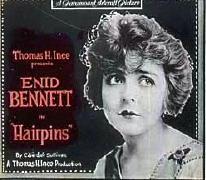
This film, which I had seen before, was substituted for Over There, a WWI patriotic drama. I like to expand my repertoire, but since Hairpins is a charming light drama, I happily sat through it again.
Muriel Rossmore (Enid Bennett) has settled too comfortably for her husband Rex’s liking (Matt Moore) into the role of frumpy wife, so he begins a dalliance with Effie, his attractive, nattily dressed secretary (Margaret Livingston).
When Muriel finds out about the affair, she consults her stylish neighbor, grass widow Mrs. Kent (Grace Morse), who supervises a new look for her and introduces her to Hal Gordon (William Conklin), a playboy friend who pays her the kind of attention that husband Rex finds mightily offensive when he stumbles on to what his wife is doing during his evenings out wth Effie.
Fred Niblo married his star during the production of this film, and his direction is a tribute to her charm and beauty. I’ve credited the art director and the creators of the attractive intertitles for their contribution to the style and wit of this delightful film.
Sun 9 Mar 2014
REVIEWED BY DAN STUMPF:
THE MANCHU EAGLE MURDER CAPER MYSTERY. United Artists, 1975. Gabriel Dell, Jackie Coogan, Huntz Hall, Joyce Van Patten, Dick Gautier, Vincent Gardenia, Anjanette Comer, Barbara Harris and Will Geer. Also with Old Tom and Winston as themselves. Written by Dean Hargrove and Gabriel Dell. Directed by Dean Hargrove.
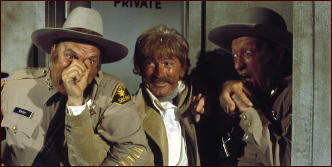
Surprisingly off-beat and witty (considering that it comes from an ex-Dead End Kid and the creator of Matlock) this is also a film of engaging pointlessness and the sort of absurd humor that later characterized Airplane and The Naked Gun.
Gabriel Dell, that perennial hanger-on from the Bowery Boys, stars as Malcolm, a bio-engineer (he’s trying to develop a chicken that will lay Easter eggs) in a speck-sized community (the richest man in town lives in a double-wide trailer) who decides to try his luck as a Private Detective and gets involved in a case of murder, adultery, incest and bestiality, all handled very tastefully and with considerable style.
For a film where Jackie Coogan and Huntz Hall play cops, this is also rather well-acted. Dell, a veteran of more bad movies than I can remember or he could forget, injects a Bogart-like weariness into his role, supported by Nicholas Colasanto as a bartender who speaks in clichés, Anjanette Comer as a flower child who spouts wisdom from fortune cookies, and Nita Talbot as a concerned wife looking for her missing husband (he’s been gone all day) who enters Dell’s office already wearing widow’s weeds.
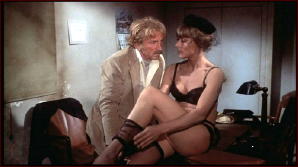
Gardenia and Geer do their usual best, un-flapped by the silliness around them, and Old Tom and Winston put in cameo appearances neat enough to merit special mention.
Eagle proceeds merrily on its way to no place special, speeded along by zany characters, neck-snapping non sequiturs, and a shoot-out like something out of Monty Python. And it caps off with a surprisingly thoughtful (and quite funny) discourse on the folly of pursuing dreams and why we do it anyway. In all, a rough little gem but one worth seeing.
Thu 6 Mar 2014
Posted by Steve under
Reviews1 Comment
IT IS PURELY MY OPINION
Reviews by L. J. Roberts
CHRISTOPHER FOWLER – The Memory of Blood. Bantam,US, hardcover, March, 2012; softcover, September 2013. (Police procedural: Bryant & May, 9th in series.)
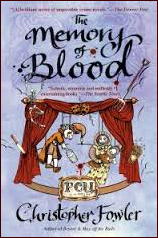
First Sentence: The following undated document appeared on Wikileaks and is now the subject of a government investigation.
During the cast party, someone has murdered the theater owner’s infant son. The bedroom is locked from the inside and neither blood nor fingerprints are found; only the life-sized puppet of Mr. Punch, lying on the floor.
A cast of characters is always helpful, but usually not very inventive. From Page One, it is clear this will not be your usual read with your usual characters and each is fully developed and fascinating. They are not necessary all people you’d want to know, but each becomes real in your mind. The Peculiar Crimes Unit team, including their long-suffering superior Raymond Lamb, is colorful and imaginative.
You are immediately caught up in the author’s voice; his observations of the English and the wonderful wry humor… “People described Salterton as ageless in a way that wasn’t intended as a compliment. He seemed to exist somewhere between post-menopause and post-mortem.†Throughout, the author punctuates the story with simple statements of truth… “The gap between rich and poor was not just one of wealth but of accountability.â€
His use of language is to be savored… “This, then, was Arthur Bryant at work, his furrowed forehead bowed beneath the yellow light of the desk lamp, a shambling Prospero residing over the desiccated pages of his literary arcane, stirring fresh knowledge into the heady stew of ideas that filled his brain.†The dialogue is excellent with some of the exchanges between Bryant and May left to flow unhampered by interruptions of so-and-so said.
The crime itself is anything but ordinary. It is, at times, gruesome. It is also a wonderful entry into the behind scenes working of a theater and the history of Punch and Judy. Fowler is particularly good in teaching the reader about things you didn’t even know you wanted to know.
The Memory of Blood is a very good book, filled with humor, imagination, suspense, and wonderful characters. I am very happy to say there are, as of now, two more books after this … and eight wonderful books before it.
Rating: Very Good.
Wed 5 Mar 2014
Posted by Steve under
Reviews[4] Comments
WILLIAM CAMPBELL GAULT – Dead Hero. E. P. Dutton, hardcover, 1963. Diamond Books, paperback, 1988.
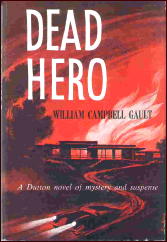
This was the seventh in the adventures of ex-football player and current PI Brock (The Rock) Callahan, and the last for nearly 20 years, until The Bad Samaritan was published by Raven House in 1980. I’d like to speak more highly of it than I’m about to, and I feel as though I should apologize when I have to say that I can’t.
Even though Callahan wraps this case up in quite satisfactory fashion, the book itself never seems to jell. His investigation of a suspected affair on the part of a old friend’s wife ends in the murder of another friend, a teammate of Brock’s with the Rams, and — mammoth coincidence, or is it? — a large canyon fire near Malibu wipes out most of the evidence.
While Brock Callahan may not always be totally ethical, he is always a moral person. While he may stay in his girl friend’s apartment overnight, he will not use her to provide a alibi for him: her reputation as one of the town’s leading businesswomen ay be ruined. On my patented Hard-Boiled Scale (from 0 to 10) this ranks as a solid Negative Five.
A couple of paragraphs later, on page 62, only confirmed what I already suspected:
She opened the door. “I’m sure you’ve visited a number of beds, Brock Callahan, but you’re an innocent just the same, aren’t you?”
“Try me sometime,” I answered wth a sneer.
The sneer was phony; the girl was right. I had never really left Long Beach.
This is not the only reason the book never seems to take shape, however. Its low-key style ever sees to get the reader involved, and even though there is a message from a dying man to be deciphered, there is not enough detective story here (until the end) to keep anyone up past past 10 o’clock in the evening.
A warm milk and cookies type of hard-boiled PI story, in other words — not the greatest combination in the world.
— Reprinted from
Mystery*File 37, no date given, slightly revised.
Mon 3 Mar 2014
LEWIS B. PATTEN – Prodigal Gunfighter. Berkley F1241; paperback original, 1966. Signet, paperback , 1976; Leisure, paperback, packaged with The Law in Cottonwood, 1994.

By sheer happenstance, this is the next western I picked up to read, and in a strong sense it picks up a thread I was working with in my review of W. C. Tuttle’s Straws in the Wind. If Tuttle’s career as a paperback writer ended in 1951 or so, Lewis B. Patten was there almost immediately to pick up the torch. His first book, Massacre at White River, came out from Ace in 1952.
Patten’s writing career continued right up until he died in 1981, when Track of the Hunter came out, also as a paperback original, this time from Signet. He was incredibly prolific. In a thirty-year span he produced something like 90 novels, including books as by Lewis Ford, Len Leighton (with Wayne D. Overholser) and Joseph Wayne (also in collaboration with Overholser).
As one of the next generation of western writers, all of Patten’s novels appeared in the post-pulp era but (as far as I know) they were all still very much in the strong “code of the west†tradition. It’s certainly difficult to generalize on the basis of one book, and Prodigal Gunfighter is the only book of his that I’ve read in several years, and probably more than that.
Not that Patten didn’t write for the pulps. Starting in 1950 he had a score or more shorter works that appeared in magazines like Mammoth Western, Thrilling Western, Frontier Stories and so on. His name is certainly more identified with novels, however, and in his heyday, he was cranking them out like almost nobody else.
And he was published in hardcover as well. He may have begun in softcover only, but beginning with Guns at Gray Butte in 1963, more and more of books came out from Doubleday. Not all of them, but a high percentage of them, the easy explanation for why not all of them was that he probably wrote more books than Doubleday could publish.
Take 1966 for example. He wrote No God in Saguaro and Death Waited at Rialto Creek for Doubleday; The Odds Against Circle L for Ace; and Prodigal Gunfighter for Berkley. Not that year, but in the same time period, he also wrote for Lancer and Signet, the latter eventually becoming his primary publisher in paperback, both for originals and reprints of the Doubleday novels.
If you want a slim and lean western to read, one that you will pick up and not put down until you’re done, then the 128 page Prodigal Gunfighter is the book for you. Taking place in the space of only a day in the small town of Cottonwood Springs, Patten certainly doesn’t leave the reader much time to breathe.
The early morning finds the entire town down at the railroad station, waiting for the prodigal to return, in the person of the notorious home-grown gunfighter Slade Teplin. Included among them is a rather nervous deputy sheriff Johnny Yoder, who has been semi-courting Teplin’s wife, Molly, a school teacher who thought she could tame him, couldn’t, but who has not yet divorced him.
Is he the reason for Slade’s return? Slade has had no contact with Molly since he left town. His father still lives in Cottonwood Springs, but there’s hardly any love lost between the two of them. Does he want revenge of some sort against the entire town? It is pure hatred? No one seems to know, and the sense of fear in the town is everywhere.
And no one can do anything, including the law. In all but his first of many killings over the years, Slade has never drawn first. On page 91 Slade is briefly confronted by the sheriff:
… Arch said finally, “So that makes it murder doesn’t it? It’s just like a rigged poker game where you know you’re going to win because you’ve stacked the cards.â€
“I always let the other guy draw first.â€
“Sure. Sure you do. You can afford to. Besides, it’s smart. It gives you immunity from prosecution. But you know, every time who it is that’s going to die. Like with Cal Reeder earlier today.â€
Cal Reeder was a kid, the son of a wealthy local rancher, who thought he’d make a name for himself and failed. His father is part of the story, and so are the four drifters that Johnny notices having come quietly into town.
Even at the short length the plot does not go exactly where it seems expected to do, and on pages 114-115 is one of the best choreographed fist-fights (not shoot-outs) I’ve read in quite a while, and it’s not even with Slade Teplin. He’s still on the loose, however – don’t worry about that – and with plans to cause even more havoc in Cottonwood Springs.
To show you want I mean, though, here’s at least how the end of the fight reads:
Johnny followed him over the desk-top and landed once more on top of him. The man was fighting with a silent desperation now, fighting for his life. Each blow he struck had a sodden, smacking sound both his fists and Johnny’s face were wet with blood. And he was tough. He was wiry and strong and no stranger to this kind of fight.
But he lacked one thing, one thing that Johnny had – anger, righteous indignation and outraged fury. Johnny had those things in quantity. For every blow the stranger struck, Johnny retaliated with another, harder one.
The man was weakening. They rolled against the glass-strewn floor to the window and back again. And at last Johnny felt the man go limp.
After a few seconds taken to recover, Johnny knows he needs to make the man talk. From page 116:
Johnny said softly, “You’re going to talk, you son-of-a-bitch, or I’m going to kick your head in. You understand what I said?â€
He’s not bluffing. The west was a tough place to live, but Patten’s characters also seem to be tough enough themselves and equal to the challenge when they need to be. What’s more traditional than that?
PostScript: Written later in Patten’s career is a book called The Law in Cottonwood (Doubleday, 1978). While I’m curious, I do not know whether the later book has any of the same characters as this one.
— Reprinted from Durn Tootin’ #7 , July
2005 (slightly revised).
Sun 2 Mar 2014
JONATHON KING – A Visible Darkness. Signet paperback reprint; 1st printing, April 2004. Hardcover edition: Dutton, 2003.

The first book in this series was The Blue Edge of Midnight, and in 2003 that was the book that won the MWA’s Edgar award for the Best First Mystery Novel (American). Unfortunately I’ve not had the pleasure of reading that earlier book, so before starting this one, the Signet reprint, all I had to rely upon were the several pages of quotes inside the front cover, from all kinds of sources. King has been compared most often, it appears, with Michael Connelly and James Lee Burke.
This is embarrassing. I’ve not read Connelly, and the one Burke I began, I stopped after a chapter or so. This is rather disgraceful on my part, and now that I am much older, I fully intend to move both authors a notch higher on the To-Be-Read pile really soon now.
But I digress. King’s leading character is Max Freeman, an ex-Philadelphia cop who had enough of the dirty Philly streets, and he now lives in seclusion in a former hunting lodge on the edges of the Everglades. There is a back story behind this, it goes without saying, and apparently not all of it was not told in the earlier volume, as it continues to be revealed in short, incisive bits and pieces in this one.
Max has two friends. One is Billy Manchester, a black attorney – one of the few success stories to emerge from the Philadelphia ghetto – who calls Max out of his private sanctuary to help him on a case of serial murders he believes he has uncovered in the established black community. The other is a very sharp police detective named Sherry Richards, with whom he is also on good terms, most of the time.
Unfortunately – from my point of view, and maybe not yours – we know who the killer is in Chapter One. It is an insurance racket, however, and who is pulling the strings is kept a secret by the author until page 160, when the case is all but solved. That there are still well over a hundred pages to go should tell you that an old-fashioned detective investigation is not one of King’s primary points of focus.
On the other hand, characterization, dialogue and a sharp eye for locale are definitely among his strong points. Whether it’s the smell of the mangroves and the flooded cypress forests of the Everglades – about which perhaps there should have been more – or the tangy, edgy sense of awareness of being in the wrong section of town, on the other side of the tracks, or doing the police beat in West Palm Beach – King’s been there, and he’s able to tell us what it’s like.
No wonder. He’s also been a long-time journalist and an award-winning news feature writer for the South Florida Sun-Sentinel. While the book may be deficient as a novel of finely-tuned detective fiction, from the level of the streets, it’s as bold as brass and almost as striking.
The Max Freeman series —
1. The Blue Edge of Midnight (2002)
2. A Visible Darkness (2003)
3. Shadow Men (2004)
4. A Killing Night (2005)
5. Acts of Nature (2007)
6. Midnight Guardians (2010)
[UPDATE] 03-02-14. Another series I’ve lost track of, but I have an excuse, of sorts. The last couple of the books have been published by a small independent press and (I believe) only in hardcover. Even though my comments at the time I wrote this review could only be called mixed, it’s good to see that the series continued on in spite of my lack of participation.
Sat 1 Mar 2014
A TV Western Review by MIKE TOONEY:
“The Trace McCloud Story.” From the Wagon Train series: Season 7, Episode 24 (250th of 284). First broadcast: 2 March 1964. Regular cast: John McIntire (Christopher Hale), Robert Fuller (Cooper Smith, credit only), Frank McGrath (Charlie Wooster), Terry Wilson (Bill Hawks), Denny [Scott] Miller (Duke Shannon), Michael Burns (Barnaby West). Guest cast: Larry Pennell, Audrey Dalton, John Lupton, Paul Newlan, Rachel Ames, Stanley Adams, James McCallion, Nora Marlowe, Harry Harvey. Writer: John McGreevey. Director: Virgil W. Vogel.
Whenever a long-running TV series runs short of ideas, they sometimes depart from their usual genre (in this case, the Western) to borrow from other genres (in this instance, the mystery/whodunit).
As Christopher Hale’s wagon train wends its way westward, they sometimes have to stop for replenishment in small towns along the trail. It so happens that in Bedrock, one of their stops, they get to enjoy a traveling magic show — which is abruptly terminated by a murder.
Wagonmaster Hale learns then that a series of stranglings have occurred in Bedrock, and the local marshal doesn’t have a clue who’s doing them.
Almost immediately a sizable percentage of the nervous citizens of the town, as well as the itinerant magician, join up with the wagon train. So does the marshal, who thinks the strangler might find the prospect of more potential victims attractive. While Hale welcomes the marshal’s presence, he knows his life just got a lot more complicated.
The marshal’s suspicions seem to be confirmed when several more murders happen as the train moves on, with the strangler barely escaping detection each time.
At this point, Chris Hale would be justified in wondering if there’ll be anybody left when they finally reach the end of the trail.
This episode does a very good job of keeping us guessing by ingeniously shifting suspicion around among the characters; the story benefits by having an hour and half to play in, giving ample time to insert red herrings.
The solution, admittedly far-fetched, does border on the implausible, but the fun, as in all thrillers, is getting there.
« Previous Page






